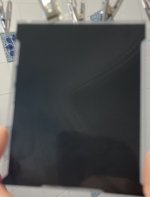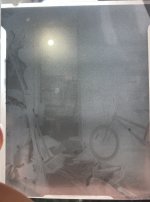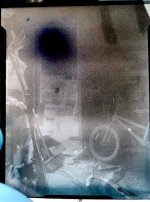I took a photo today that had a pretty extreme contrast range so I could play around with trying to retain some highlight detail in development. I have since however found conflicting information regarding how much time to cut. I have seen cutting it in half and cutting it by 30%. Is there no hard and fast rule?
and help to keep the site free for all
You are using an out of date browser. It may not display this or other websites correctly.
You should upgrade or use an alternative browser.
You should upgrade or use an alternative browser.
Cutting development time for highlights
- Thread starter Nebular89
- Start date
StephenM
I know a Blithering Idiot
- Messages
- 4,966
- Name
- Stephen
- Edit My Images
- Yes
It depends on how much contrast you want to lose, so in the absence of a fixed goalpost, there's no fixing the amount required. If you read up on the zone system (which I don't use, never having found the need with my subjects) you'll find (or should find) how much extra exposure to give to cut development by 15% and 30% and the effect that that will have on the contrast. To use the zone system, you need to know the contrast range of your subject which requires either a spot meter or close up readings (and a lot of complexity and potential error lies in that simple statement), what exposure index to use with your equipment to give results you want, and what your standard development time should be. A lot of experiments in fact before you can properly expose anything. And far beyond what I'm prepared to do, to be honest. And remember that the ideal contrast for your negative will depend on whether you use a condensor enlarger, a diffuser enlarger or a scanner.
An older edition of one of Michael Langford's books (from before digital caused a lot of useful info to be cut out) had example photos of a high contrast subject showing the effect of increased exposure with the same development time, and cutting development time with the same exposure. The main thing I took away was after the first few minutes of development (three or four) shadow detail didn't darken, and contrast built up. There's a lesson in there somewhere for stand development...
I'll give a rough rule of thumb based on what others have said, but with the caveat that I've never varied development or exposure to suit the subject. Perhaps I'd be a better photographer if I did, but there we are. If you want to cut contrast a bit (intentionally imprecise term) add a stop of exposure and knock off 15%, if more, make it 2 stops extra and knock of 30%.
An older edition of one of Michael Langford's books (from before digital caused a lot of useful info to be cut out) had example photos of a high contrast subject showing the effect of increased exposure with the same development time, and cutting development time with the same exposure. The main thing I took away was after the first few minutes of development (three or four) shadow detail didn't darken, and contrast built up. There's a lesson in there somewhere for stand development...
I'll give a rough rule of thumb based on what others have said, but with the caveat that I've never varied development or exposure to suit the subject. Perhaps I'd be a better photographer if I did, but there we are. If you want to cut contrast a bit (intentionally imprecise term) add a stop of exposure and knock off 15%, if more, make it 2 stops extra and knock of 30%.
- Messages
- 254
- Edit My Images
- No
It depends on how much contrast you want to lose, so in the absence of a fixed goalpost, there's no fixing the amount required. If you read up on the zone system (which I don't use, never having found the need with my subjects) you'll find (or should find) how much extra exposure to give to cut development by 15% and 30% and the effect that that will have on the contrast. To use the zone system, you need to know the contrast range of your subject which requires either a spot meter or close up readings (and a lot of complexity and potential error lies in that simple statement), what exposure index to use with your equipment to give results you want, and what your standard development time should be. A lot of experiments in fact before you can properly expose anything. And far beyond what I'm prepared to do, to be honest. And remember that the ideal contrast for your negative will depend on whether you use a condensor enlarger, a diffuser enlarger or a scanner.
Another point of course being that contrast is scene-dependent so the full extent of the Zone System can only be applied if one is exposing and developing one sheet at a time (eg, LF).
With roll film and 35mm compromises must be made (unless one of course takes 12 or 36 images of the same subject in identical contrast settings
- Messages
- 9,240
- Edit My Images
- No
Have you investigated "stand development"?I took a photo today that had a pretty extreme contrast range so I could play around with trying to retain some highlight detail in development.
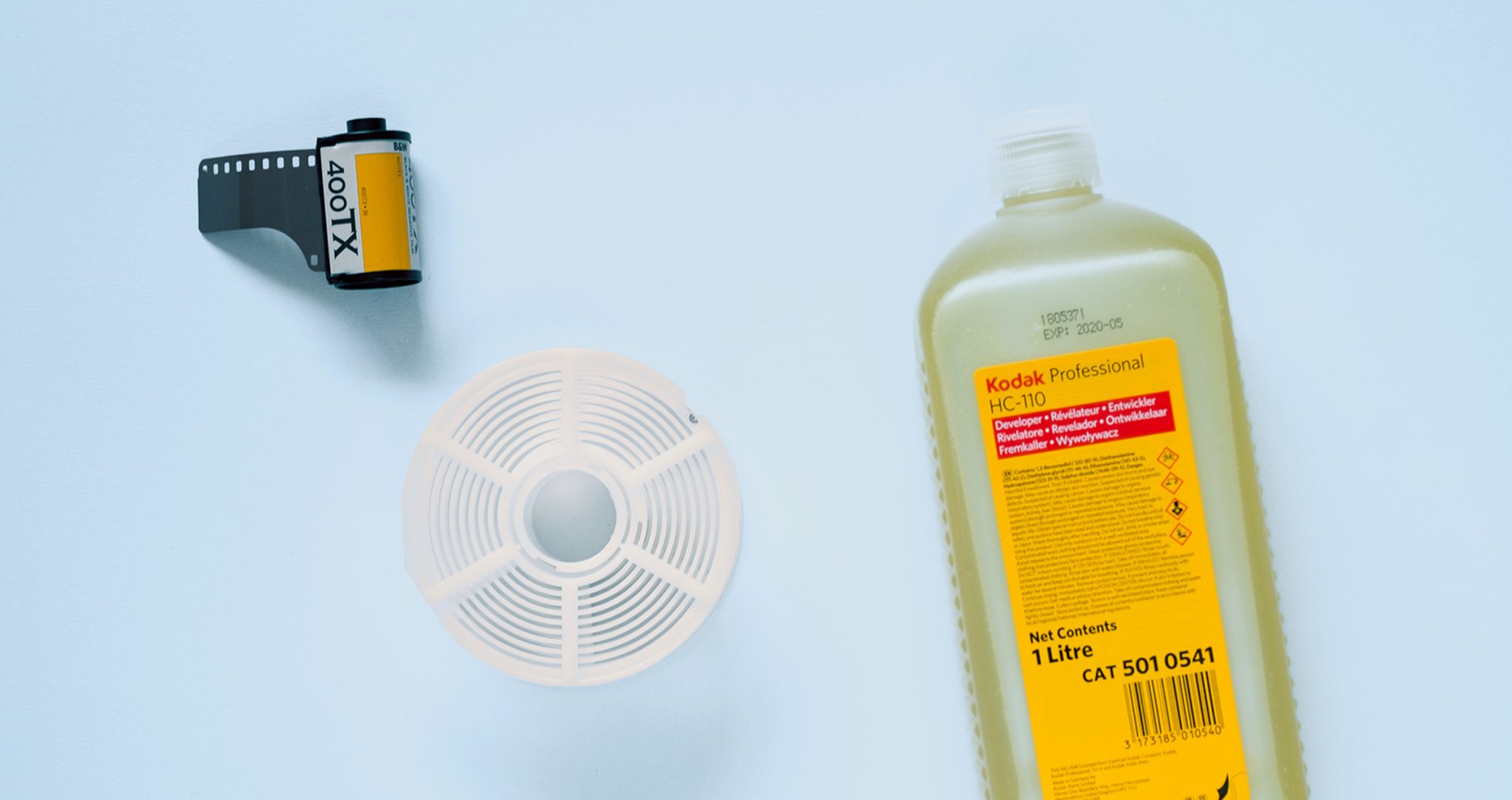
How To Stand Develop Film
Heard about stand developing but not sure what it is? In this guide, we will explain everything you need to know. Learn how to stand develop film.
 parallaxphotographic.coop
parallaxphotographic.coop
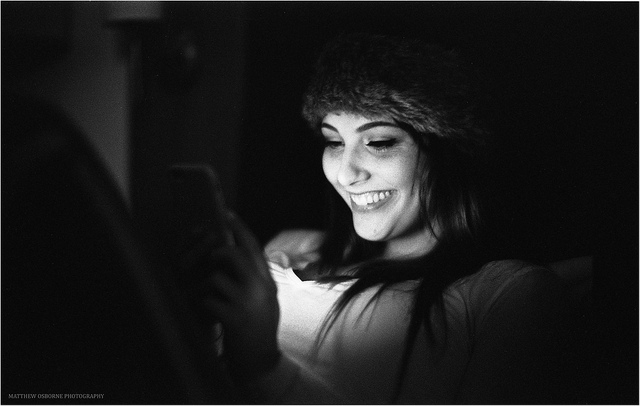
Rodinal Stand Development (How To!) / Rodinal Developer
Rodinal Stand Development + Rodinal Semi-Stand Development - Example photos developing black and white film in R09 One Shot + How to Guide! +
 mrleica.com
mrleica.com
D
Deleted member 95430
Guest
Different times as everyones chems and techinques are different
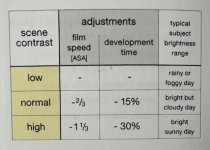
From Way Beyond Monochrome 2.
As long as you start at a sensible starting point you can dial it in depending on whether you are getting the results you want
I like the table above as its simple and I dont always want to be calculating EVS all over the scene

From Way Beyond Monochrome 2.
As long as you start at a sensible starting point you can dial it in depending on whether you are getting the results you want
I like the table above as its simple and I dont always want to be calculating EVS all over the scene
- Messages
- 9,773
- Name
- wayne clarke
- Edit My Images
- Yes
My old trick was to over expose by a stop and cut a third off the dev time, that used to reduce contrast without reducing the exposure. As you've already exposed the film I'd probably still go with a third off the time though.
PerfectMy old trick was to over expose by a stop and cut a third off the dev time, that used to reduce contrast without reducing the exposure. As you've already exposed the film I'd probably still go with a third off the time though.
I’ve shed stand development before in 35mm but only because I’d pushed hp5 to 1600. I’ve never done it to account for the highlights, I didn’t know that was a thing.Have you investigated "stand development"?

How To Stand Develop Film
Heard about stand developing but not sure what it is? In this guide, we will explain everything you need to know. Learn how to stand develop film.parallaxphotographic.coop

Rodinal Stand Development (How To!) / Rodinal Developer
Rodinal Stand Development + Rodinal Semi-Stand Development - Example photos developing black and white film in R09 One Shot + How to Guide! +mrleica.com
I’ve seen a couple of people using stand developing for hp5 even shot at 400 before
Also does developer matter? I’ve got rodinal and ilfotec hc. I was going to try the ilfotec to make sure it was still ok, it’s been open a while.My old trick was to over expose by a stop and cut a third off the dev time, that used to reduce contrast without reducing the exposure. As you've already exposed the film I'd probably still go with a third off the time though.
Can’t rodinal increase contrast a bit? I don’t know where I heard that!
Last edited:
- Messages
- 9,773
- Name
- wayne clarke
- Edit My Images
- Yes
Not tried it with Rodinal, I used to use ID11 or Microphen for the most part. Microphen for pushing HP5.Also does developer matter? I’ve got rodinal and ilfotec hc. I was going to try the ilfotec to make sure it was still ok, it’s been open a while.
Can’t rodinal increase contrast a bit? I don’t know where I heard that!
It used to work pretty well. Contrasty but looked decent to meNot tried it with Rodinal, I used to use ID11 or Microphen for the most part. Microphen for pushing HP5.
So I just finished developing the negatives including the dynamic range test.
To the eye the negative is black but under a very strong light (the sun) there is details. Somehow the negative has details inside my garage but also outdoors. I checked the exposure on my digital camera and the entire outdoors was blown out so I’m impressed there’s anything there to be honest. However the negative doesn’t look useable at all to me. I used ilfotek Hc 1:31 with the developing time cut from 7min to 5. I did another 3 negatives in the tank and they came out perfectly, they look really good. So I’m assuming cutting the development by 30% wasn’t the issue as such, it’s more that that development didn’t fit that negative. Or I really messed up the exposure and it was never going to come out!
To the eye the negative is black but under a very strong light (the sun) there is details. Somehow the negative has details inside my garage but also outdoors. I checked the exposure on my digital camera and the entire outdoors was blown out so I’m impressed there’s anything there to be honest. However the negative doesn’t look useable at all to me. I used ilfotek Hc 1:31 with the developing time cut from 7min to 5. I did another 3 negatives in the tank and they came out perfectly, they look really good. So I’m assuming cutting the development by 30% wasn’t the issue as such, it’s more that that development didn’t fit that negative. Or I really messed up the exposure and it was never going to come out!
Attachments
- Messages
- 8,314
- Name
- Ian
- Edit My Images
- No
I think that there are just too many variables to make it a scientific absolute. One thing to note is that just under-developing will simply give you an under-exposed image. You should probably over-expose at the time of shooting to compensate.
I tend to cut by a third and have had some success. Sadly, without developing it twice (once normally and once pulling it) I'll never really know what difference it made. I routinely shoot Washi-Z at 200. Over-exposing by 1 stop then under-developing by 1/3.
One thing's for sure though. If you're using a developer that has very short dev times for the film you're using, then it can make it a bit dicey. I never had much success with Rodinal although many others swear by it. The film stock can also be challenging as some film doesn't respond well to pulling.
This is well worth a watch.
View: https://www.youtube.com/watch?v=OdpfRqDDZyw
I tend to cut by a third and have had some success. Sadly, without developing it twice (once normally and once pulling it) I'll never really know what difference it made. I routinely shoot Washi-Z at 200. Over-exposing by 1 stop then under-developing by 1/3.
One thing's for sure though. If you're using a developer that has very short dev times for the film you're using, then it can make it a bit dicey. I never had much success with Rodinal although many others swear by it. The film stock can also be challenging as some film doesn't respond well to pulling.
This is well worth a watch.
D
Deleted member 95430
Guest
One thing to note is that just under-developing will simply give you an under-exposed image.
Not necessarily, if have a high contrast scene, metering for the shadows under developing (i.e compared to normal times) will prevent highlights blowing - if I over exposed in this situation my shadows would be too bright
I also think you can be quite scientific about it if you have the time and keep many things constant purely for speed and dev time testing. This wont work in the field though
- Messages
- 8,314
- Name
- Ian
- Edit My Images
- No
I mean, technically, this is arguably over-exposing.... But I'm not going to split hairs because I know what you mean.metering for the shadows under developing (i.e compared to normal times) will prevent highlights blowing
[Edit - I just realised I split the hair by replying... Sorry!
Last edited:
I think I need to do it again and develop 2 independently. I’mI think that there are just too many variables to make it a scientific absolute. One thing to note is that just under-developing will simply give you an under-exposed image. You should probably over-expose at the time of shooting to compensate.
I tend to cut by a third and have had some success. Sadly, without developing it twice (once normally and once pulling it) I'll never really know what difference it made. I routinely shoot Washi-Z at 200. Over-exposing by 1 stop then under-developing by 1/3.
One thing's for sure though. If you're using a developer that has very short dev times for the film you're using, then it can make it a bit dicey. I never had much success with Rodinal although many others swear by it. The film stock can also be challenging as some film doesn't respond well to pulling.
This is well worth a watch.
View: https://www.youtube.com/watch?v=OdpfRqDDZyw
Funnily enough that’s the video I saw a long time ago that gave me the idea of cutting the development time.I think that there are just too many variables to make it a scientific absolute. One thing to note is that just under-developing will simply give you an under-exposed image. You should probably over-expose at the time of shooting to compensate.
I tend to cut by a third and have had some success. Sadly, without developing it twice (once normally and once pulling it) I'll never really know what difference it made. I routinely shoot Washi-Z at 200. Over-exposing by 1 stop then under-developing by 1/3.
One thing's for sure though. If you're using a developer that has very short dev times for the film you're using, then it can make it a bit dicey. I never had much success with Rodinal although many others swear by it. The film stock can also be challenging as some film doesn't respond well to pulling.
This is well worth a watch.
View: https://www.youtube.com/watch?v=OdpfRqDDZyw
Is there any general idea of what might have happened to the negative? If it’s black isn’t it over exposed? It was a long exposure, perhaps a couple of minutes, but I had metered correctly for the inside of the garage. I’ve never had a negative look like it before.
I can’t see how it could be the development seeing as the other 3 in the same tank came out looking fine
I can’t see how it could be the development seeing as the other 3 in the same tank came out looking fine
D
Deleted member 95430
Guest
Id chalk it up to the LF fairies, you might go crazy otherwise
- Messages
- 9,773
- Name
- wayne clarke
- Edit My Images
- Yes
One of the things we did in college back in the day was shoot a short roll of film at the correct exposure, then another a stop or two over and same again a stop or two under. Then in the darkroom we'd cut these into short lengths and dev for different times wrting down the results with the neg bags. This gave us a fair bit of help working out what worked with our cameras and meters. Cheap enough to do back then with bulk film and college dev.
I think I’ll try it again and do it as a stand development and see what happens.One of the things we did in college back in the day was shoot a short roll of film at the correct exposure, then another a stop or two over and same again a stop or two under. Then in the darkroom we'd cut these into short lengths and dev for different times wrting down the results with the neg bags. This gave us a fair bit of help working out what worked with our cameras and meters. Cheap enough to do back then with bulk film and college dev.
It could be that I got the exposure wrong. I did another long exposure and the highlights were a bit blown, I know fomapan 100 has crap reciprocity times
- Messages
- 254
- Edit My Images
- No
Is there any general idea of what might have happened to the negative? If it’s black isn’t it over exposed?
Any chance the shutter is sticky?
I don’t think so, I’ll double check but I was in bulb which I think is ok. All the speeds sound good to my ear down to 1sec so they’re probably close enough.Any chance the shutter is sticky?
The exposure was long. From memory (I should have made a note) 2min ish, so I wouldn’t have though the shutter sticking open a little would have made a difference.
I have a feeling it was the exposure that was wrong though. I’m thinking I didn’t calculate it properly. I’ve done long exposures before but this had light spilling in through a door and I only exposed for the shadows. Maybe over the course of the long exposure the light spilling in caused it to be massively over exposed?
I tried scanning it yesterday with a camera and a macro lens but it was so dark it wouldn’t even focus so it’s unusable.
StephenM
I know a Blithering Idiot
- Messages
- 4,966
- Name
- Stephen
- Edit My Images
- Yes
I honestly don't know if you can still buy them ready made, but you could look for Farmer's Reducer (a chemical named after Howard? Farmer to remove silver from negatives, not a diet plan for agricultural workers).
I honestly don't know if you can still buy them ready made, but you could look for Farmer's Reducer (a chemical named after Howard? Farmer to remove silver from negatives, not a diet plan for agricultural workers).
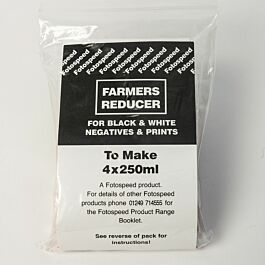
Fotospeed FR10 Farmers Reducer 4x250ml
A silver reducer supplied as powder. Traditionally used for B&W negatives. Can also be used for reducing the density of B&W prints or any material where silver is the base. Hypo crystals are supplied in the kit for the refixing of the image after reduction.


